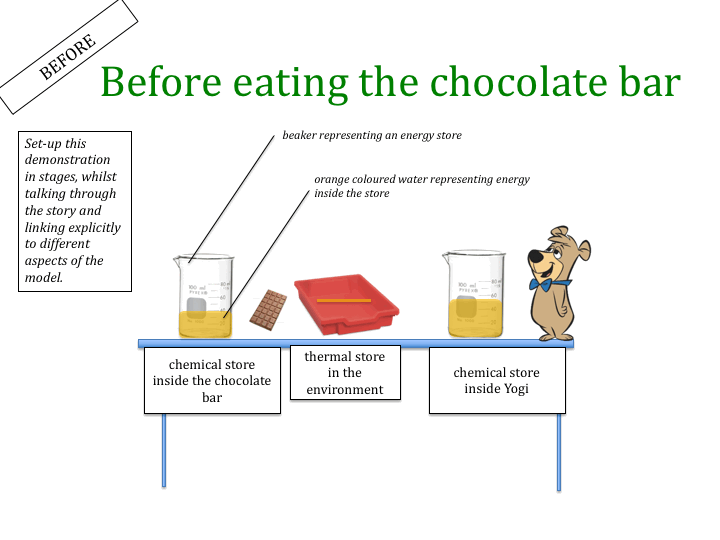Energy teaching resources
Worksheets and lesson ideas to challenge students aged 11 to 16 to think hard about energy and power (GCSE and Key Stage 3)
Overview: energy is undoubtedly a tricky concept for students to understand. Simple definitions, although useful in the short term, can prove problematic for students later on so perhaps are best avoided. Many of us grew up using forms of energy, such as kinetic or thermal, which led us to believe that there are different forms of energy, but energy is energy is energy. To overcome this issue in the UK the stores and transfers model is now taught. When energy is transferred from one store to another then work is done. Dissipated energy, sometimes called wasted energy, is energy that ends up in the thermal store of the surroundings. This is an excellent article written by Robin Millar looking at how we should approach the teaching of energy.
Key concept: energy can be transferred usefully, stored or dissipated, but cannot be created or destroyed. When energy is transferred from one store to another then work is done.
From big idea: total amount of energy in the universe is always the same but can be transferred from one energy store to another during an event
Linked knowledge: heating, internal energy, specific heat capacity, particle motion
Misconception [scientific idea]: energy is used up [energy is transferred from store to store]; only moving objects have energy [an object can continue to move, even when there is no energy transfer taking place]; energy is a fuel [fuels have energy in their chemical store, this energy can be transferred to the thermal store of the surroundings by heating]
Teaching resources
The video below is a great introduction to energy stores and transfers.
Where to start?
The word energy does not appear anywhere in the primary programme of study for science. However, that doesn’t mean that students won’t have heard the word before. Looking at food labels can be a good place to start, as can heating a beaker of water using a Bunsen and considering the energy transfers involved. Remember to keep it simple and don’t try to explain every energy transfer event that takes place, focus on the key changes ie the start and end.
 Energy stores and transfers – introducing the model
Energy stores and transfers – introducing the model
Energy transfers and stores teacher demonstration (drat). This teacher demonstration introduces students to the stores and transfers model. This slide deck hopefully helps you to carry out the demonstration. Further practice questions on stores and transfers written by Ruth Ashbee are here to download. Ruth’s thinking about the new energy model is here.
How much energy is in the chemical store found inside food?
A great investigation to explore energy in food is available on the investigations page. Students investigate whether they should take quavers or rice cakes on a mountain climb.
Kinetic energy stores
For a long time I struggled to understand the concept of the kinetic store as I expected it to be a kinetic pathway as it involved something moving. Thinking of an object moving in space helped me. The moving object doesn’t need energy to keep moving. The energy inside the kinetic store of the object is only transferred when the object hits something. In this case energy would be transferred from the kinetic store inside the moving object to the thermal stores of a) the object it hit b)itself and c) the surroundings. A fidget spinner could also be used here to illustrate this idea.
Modelling efficiency
You can adapt the demonstration done above for stores and transfers to model efficiency. Start with two 100 ml cylinders and orange coloured water. Demonstrate efficient pouring from one cylinder into the other and then inefficient pouring over a tray lined with absorbent paper. Calculate efficiency from volume readings for both processes. Idea suggested by @emc2andallthat.
Calculating power and efficiency
GCSE worksheet to calculate power and efficiency for electrical devices. This activity asks students to use their prior knowledge to arrange a series of lights in order of power. Students then calculate the power of the lights to see if their predictions were correct. We then consider why two bulbs with different power ratings can produce the same amount of light; this leads on to a discussion of efficiency. (PDF)
Conservation of energy
Energy resources – renewable and non-renewable
Joule island is an imaginative way to get students to apply their knowledge of energy resources to a new context. You could easily adapt this activity and get students to build working models of the island, or perhaps ask students to present to the ‘island governor’ which two energy resources are the best to use and why. Click on the link for further resources to support with this lesson.
Further reading
- Visit the Institute for Physics energy pages.
- Tracy, C., 2014. Energy in the New Curriculum: An Opportunity for Change. School Science Review, 96(354), pp.51-61.
